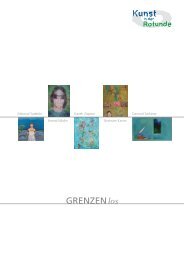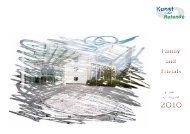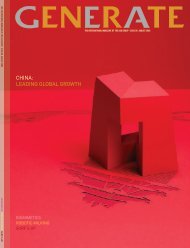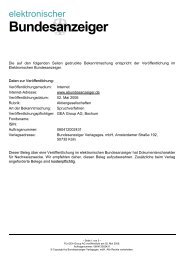A BREATH OF FRESH AIR SAY CHEESE WAR ON ... - GEA Group
A BREATH OF FRESH AIR SAY CHEESE WAR ON ... - GEA Group
A BREATH OF FRESH AIR SAY CHEESE WAR ON ... - GEA Group
Create successful ePaper yourself
Turn your PDF publications into a flip-book with our unique Google optimized e-Paper software.
The world’s deserTs<br />
receive more energy<br />
from The sun in<br />
six hours Than The<br />
planeT’s populaTion<br />
uses in a year. could<br />
harnessing The<br />
power of The deserT<br />
sun provide The<br />
long-Term soluTion<br />
To meeTing global<br />
energy needs?<br />
bu Dhabi in the United Arab Emirates is<br />
one place in the world that need not worry<br />
about its energy supply. Its 67,340 square<br />
kilometers holds eight per cent of global<br />
oil reserves and five per cent of natural gas<br />
reserves – enough to last for 100 years.<br />
Yet, despite this natural wealth, Abu Dhabi has<br />
embarked on a sustainable program to wean<br />
itself away from hydrocarbon dependence.<br />
Instead it wants to develop a more diverse<br />
economy and to become a beacon for<br />
renewable energy and sustainable technology.<br />
Masdar, a multi-faceted renewable energy<br />
company of the Abu Dhabi governmentowned<br />
Mubadala Development Company,<br />
is spearheading this sustainability drive. Its<br />
flagship project, Masdar City, is one of the<br />
world’s most sustainable developments,<br />
currently being built 17 kilometers from<br />
the city of Abu Dhabi. The low carbon, low<br />
waste city is a focused effort by Abu Dhabi<br />
to address the challenges of sustainable<br />
planning amid increasing urbanization.<br />
Masdar City achieves this by pioneering best<br />
practises in sustainable urban planning,<br />
design, development and operation. It<br />
has a pedestrian-friendly environment<br />
and is piloting several advanced cleantransportation<br />
systems and strategies,<br />
including personal rapid transit and electric<br />
vehicle point-to-point systems.<br />
The city is also reducing embodied carbon<br />
emissions and waste, increasing recycling,<br />
using local materials and timber from<br />
sustainable forests, and selecting products<br />
that have the greatest positive effect for<br />
indoor air quality.<br />
As it provides a unique test-bed platform that<br />
allows partners in cutting-edge technology<br />
and systems to pilot, demonstrate, refine,<br />
develop and commercialize technologies<br />
on a very fast-to-market platform, Masdar<br />
City has been chosen as the Middle East<br />
headquarters of renowned companies.<br />
In order to help the emirate reach its goal<br />
of moving towards a knowledge-based<br />
sustainable economy, Masdar operates<br />
across the full spectrum of the renewable<br />
energy and sustainable technology industry<br />
through its global and local projects.<br />
For the six years since its inception, Masdar<br />
has provided cutting-edge clean technology<br />
solutions by developing global and local<br />
solar and wind power projects. These include<br />
the unique concentrated solar power (CSP)<br />
plant Gemasolar in Spain; one of the world’s<br />
largest CSP plants, Shams One, in Abu<br />
Dhabi; and one of the world’s largest offshore<br />
wind farms, London Array in the UK.<br />
Shams Power Company is a joint venture<br />
between Masdar Power (60 per cent),<br />
Abengoa Solar (20 per cent) and Total (20<br />
per cent) and is the special purpose vehicle<br />
formed to build and operate Shams One, the<br />
100MW CSP plant in Abu Dhabi’s Western<br />
Region. The plant will provide electricity to<br />
20,000 homes and save 175,000 tonnes of<br />
CO 2. This is equivalent to planting 1.5<br />
million trees or taking 15,000 cars off Abu<br />
Dhabi roads.<br />
For the solar power industry, Shams One<br />
represents three significant milestones:<br />
it’s one of the largest projects of its kind in<br />
the world, covering 2.5 square kilometers,<br />
it’s the first utility-scale commercial solar<br />
power project in the Middle East; and, most<br />
significant of all, it’s the world’s first solar<br />
thermal power plant on desert sand. Shams<br />
One is currently under construction and is<br />
scheduled for completion by the end of 2012.<br />
Power from sunlight<br />
Like most commercial solar power plants,<br />
Shams One will convert sunlight into<br />
electricity using CSP technology. More<br />
than 258,000 thousand concave mirrors<br />
will be configured into 768 parabolic trough<br />
collectors. Each collector will concentrate<br />
the sunlight at between 30 and 60 times its<br />
normal intensity onto a receiver pipe that runs<br />
down the center of the trough. The pipe will<br />
be filled with thermal oil which then passes<br />
through a heat exchanger in the power plant,<br />
turning water into steam which then drives a<br />
turbine to generate electricity. Heat storage<br />
tanks will supply energy to the steam cycle at<br />
night and during times of peak demand.<br />
With the thermal oil reaching temperatures<br />
up to 400°C it partially degenerates and<br />
forms by-products, lowering the heat<br />
transfer. This means that it needs to be<br />
regenerated at regular intervals. <strong>GEA</strong><br />
Process Engineering developed fully<br />
automatic distillation plants for achieving<br />
this. Following the successful implementation<br />
at three solar thermal power stations in<br />
Spain this technology is set to be installed at<br />
Shams One.<br />
“Usually the oil has to be taken off site to<br />
a large distillery plant,” explains Sales &<br />
Marketing Manager at <strong>GEA</strong>, Norbert Streider.<br />
“But we came up with the idea of smaller<br />
units so that the oil could be regenerated on<br />
site. These units are also partially powered by<br />
solar energy.”<br />
He says that, although the distillation<br />
technology itself is not new, the difference is<br />
that these units can heat the oil to more than<br />
300°C for high temperature fractionation.<br />
Compared to conventional plants, the <strong>GEA</strong><br />
plant has a higher separation efficiency,<br />
allowing a recovery rate of 98-99 per cent and<br />
the reuse of thermal oil with the highest purity.<br />
Cooling first<br />
One of the main problems of locating Shams<br />
One in the desert is – unsurprisingly – the<br />
lack of water. This means that the exhaust<br />
steam from the power plant cannot be cooled<br />
conventionally, by condensation in a wet<br />
cooling tower. Instead a <strong>GEA</strong> Heat Exchangers<br />
air cooled condenser will be installed, the first<br />
at a solar thermal power plant.<br />
It was particle physicist Dr. Gerhard<br />
Knies, one of the founders of the Desertec<br />
Foundation, who calculated that the world’s<br />
deserts received more energy from the sun in<br />
six hours than the planet’s population used<br />
in a year. The Desertec Foundation is a nonprofit<br />
organization committed to promoting<br />
clean power from the deserts.<br />
It is part of the Desertec Industrial Initiative<br />
(Dii GmbH) – a consortium of European and<br />
Algerian companies – which plans to set up<br />
a vast network of solar and wind farms in<br />
the desert regions of northern Africa and<br />
transmit the electricity via high-voltage direct<br />
current cables. If successful, it could provide<br />
15 per cent of Europe’s electricity by 2050.<br />
Construction of the first Desertec solar farm<br />
is due to begin in Morocco in 2012. This,<br />
together with the Shams One project, is<br />
proving that the idea of capturing the power<br />
of the desert sun is no mirage.<br />
GENERATE MAGAZINE ISSUE 15 3

















